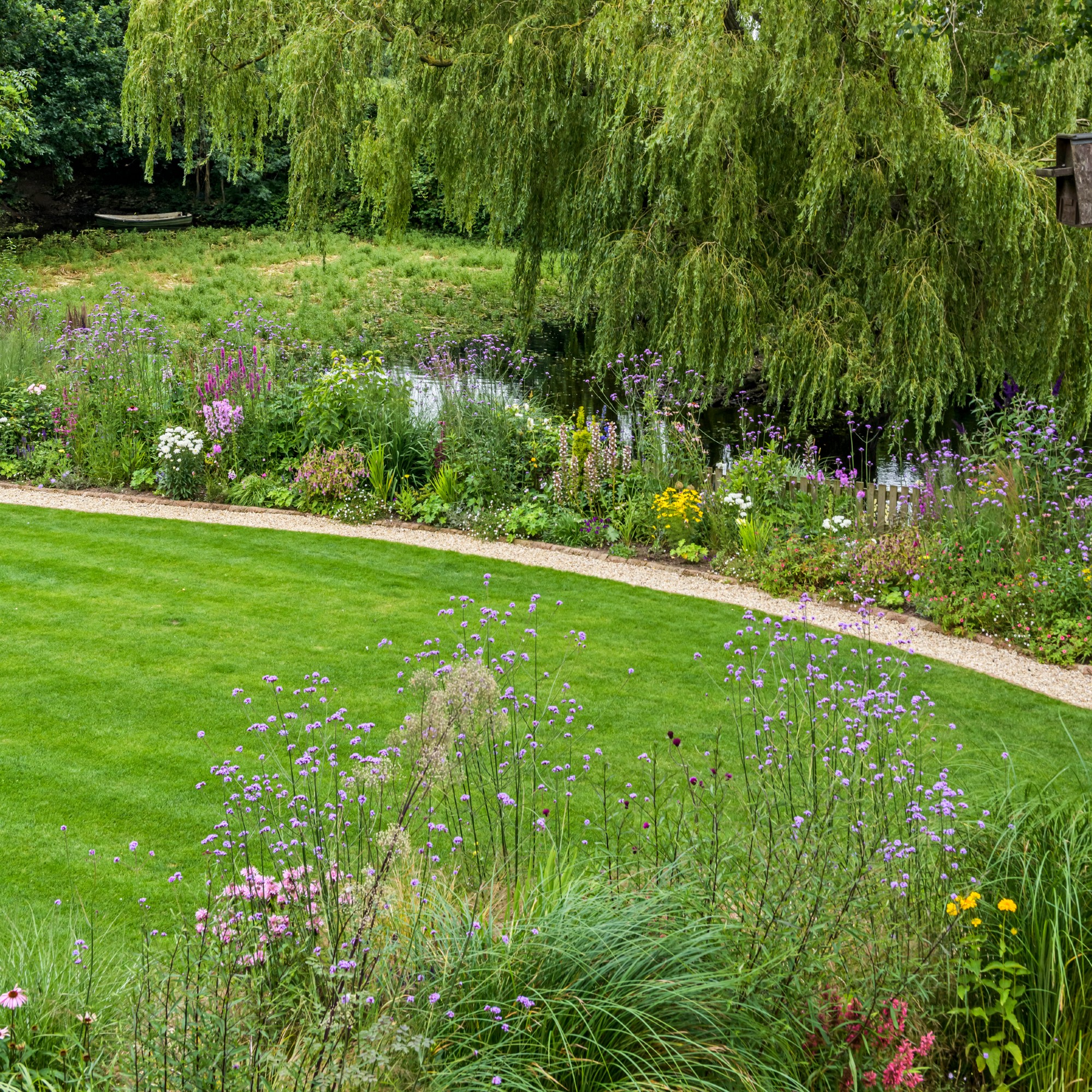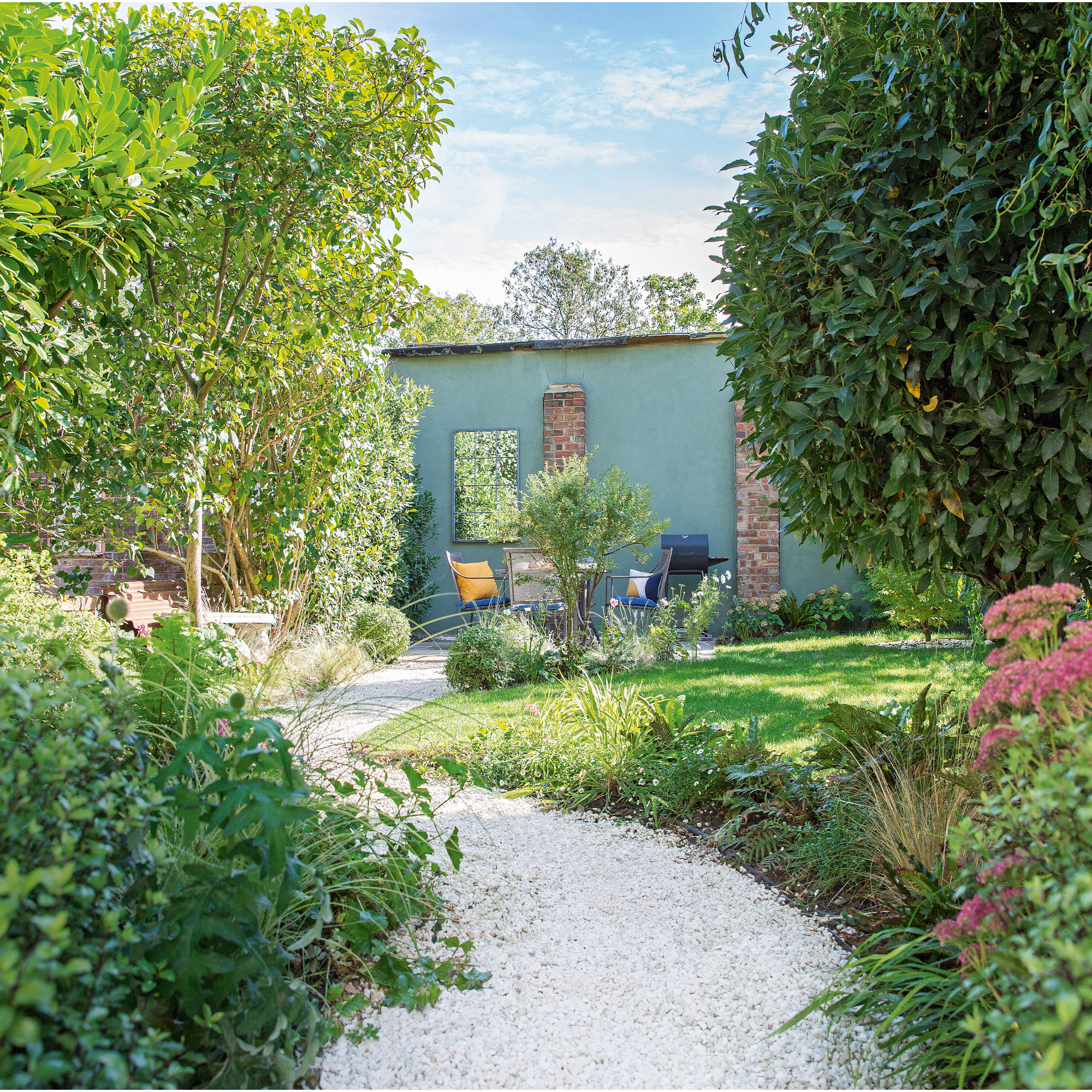
Learning how to improve drainage in a clay soil lawn is one of those things you never think you'll need to consider until you're faced with a waterlogged lawn.
If you've noticed that it takes a while for excess water to drain away after a rainy day or parts of your lawn appear to be different colours, we're sorry to tell you that your lawn is waterlogged. Understanding how to improve lawn drainage is a vital piece of lawn care, but if you're dealing with a clay soil lawn you will face a few more challenges when improving drainage than in a standard lawn.
How to improve drainage in clay soil lawn
First things first, if you are not sure if your lawn has clay soil, you should be able to tell at a glance, says Timothy Greene, Lawn Care Expert at iCANLAWN.com. ‘Clay soils will be wet and muddy during rainy seasons and become almost baked in the hot weather, with cracks on the surface.’
If you’re still unsure, pick up some soil from your lawn and rub it between your fingers. If you can easily form a ball without parts crumbling off, then you most likely have a clay soil lawn.

‘Clay soil is a type of earth which retains moisture well, yet often suffers from poor drainage due to its small and fine particle size,’ explains Peter Chaloner, Managing Director of Cobra. ‘This means maintaining a lawn on clay soil can be challenging, as it can easily become waterlogged and compacted.’
What you’ll need
- A garden fork or aerator: this Lawn Aerator from Amazon is a great option
- Organic matter/compost: try the Pelle & Sol 60L Multi-Purpose Compost Soil Bag from Amazon.co.uk
- Sand or grit
- A rake; this Wickes Stainless Steel Garden Rake has plenty of 5 star reviews
- Landscaping fabric, gravel and a perforated pipe (if installing a French Drain)
Step-by-step
1. Assess and prepare your lawn
Before you get started, it’s important to take the time to assess your lawn and identify any areas prone to waterlogging. Josh Novell, Lawn Expert and Director of Polhill, recommends ‘looking for areas where standing water is present, regularly accumulates, or where grass struggles to grow.’
One of the easiest ways to do this is to observe your lawn after a heavy rain shower. ‘Notice how quickly the water drains,’ notes Steven Bell, Gardening Expert and Managing Director of Paving Shopper. ‘If puddles linger for more than a day, you have drainage issues.’
Once you’ve confirmed this, it’s time to prepare your lawn for the next steps. For example, if your grass is particularly long, you’ll want to mow it, as longer grass can make the aeration process more difficult and take longer to do. You’ll also want to remove any debris, such as sticks, leaves or silt from the surface.

2. Aerate the soil
‘Aerating clay soil is essential for improving drainage and preventing water logging,’ says Gardenstone’s Director, Tom Clifford. ‘This works by creating holes in the soil to improve airflow and should be repeated at least once a year in clay soil. However, if your lawn gets severely waterlogged you may need to repeat this process more frequently.’
While some of the experts suggest using a specialised aerating tool for the best results, a garden fork can work just as well. ‘If you’re using an aerating tool then push it two to four inches into the ground and remove. Repeat this across the entirety of your lawn or the areas most susceptible to waterlogging. If you’re using a fork then simply push it into the lawn and wiggle it backwards and forwards to break up the soil,’ Tom adds.
Lightly watering your lawn before you begin aerating can also help to soften the soil and make it easier to create holes.
3. Incorporate organic matter
The next step is to incorporate organic matter such as compost, bark mulch or well-rotted manure into the soil. This will ultimately help to improve the structure of the soil as well as its drainage.
For example, ‘compost is rich in organic matter, and when the larger particles of this matter are added to the clay it can increase aeration and filtration in the soil. Compost is also porous by nature, meaning it can hold additional moisture whilst still having space for air to prevent a buildup of standing water,’ Craig Morley, Gardening Expert at Budget Seeds, explains.
Utilising ‘organic matter is one of the best things you can do to improve drainage in clay soil lawns,’ agrees Jane Dobbs, Team Lead at Allan’s Gardeners.

4. Topdress with sand or grit
‘When you’ve added the compost or manure, spread a layer of coarse sand or grit over the lawn, particularly in areas with poor drainage,’ Josh suggests. ‘Aim for a depth of around 1/2 inch to 1 inch and work the material into the soil using a rake.’
Just be careful not to add too much sand, as this ‘can lead to hard, concrete-like soil,’ warns Steven. ‘Instead, aim for a balanced mix of sand and organic matter to ensure the soil remains loose and fertile. Remember, the goal is to turn clay into a hospitable home for roots.’
5. Create drainage channels
water-permeableYou could also install some drainage channels into your lawn. ‘This is especially effective if your lawn is only prone to waterlogging in a few specific areas,’ according to LeisureBench's Garden Expert, Steve Chilton. ‘I recommend digging some trenches into the problematic areas, and filling them up with gravel. This will create a pathway for water to flow, rather than it sitting on the grass.’
Alternatively, a French Drain might be another option. Much like a traditional trench, this solution uses gravel plus the addition of a perforated pipe to help with drainage. Craig advises ‘digging a trench in a downhill location, or creating a slope by digging the trench at a gradient. Then lay a water permeable landscape fabric in the trench, along the bottom and up the sides, keeping enough fabric on either side of the trench to be able to wrap the pipe.’
Next, ‘fill the bottom third of the trench with aggregate, such as gravel, lay the pipe with the perforated holes facing down and add more aggregate into the trench, until it is around ten centimetres from the top of the trench.’
Finally, ‘cover the trench with the remaining landscape fabric, checking that there are no gaps (or a minimal amount) between the edges.’
While this may seem more labour-intensive, it is a great option for more extreme cases of waterlogging.

6. Water and maintain
It’s also important to understand that if you don’t regularly maintain your lawn, the problems will likely return. So, ‘after completing the improvements, water the lawn thoroughly to help settle the amendments into the soil and continue regular mowing and watering to promote healthy growth,’ Josh declares.
You can also help by reducing ‘the amount of footfall on the actual lawn by building brick or gravel paths or adding stepping stones,’ says Lucie Bradley, Greenhouse and Gardening expert at Two Wests & Elliott. ‘This way you will reduce compacting the ground even further, reducing the level of damage to the grass.’
FAQs
What issues can waterlogging cause on a clay soil lawn?
Aside from being frustrating and somewhat unsightly, if your grass or lawn is submerged in water for days on end, this can create a number of different issues. Essentially, ‘waterlogged soil can impede the flow of air, water, and nutrients, which can harm the growth of grassroots and make them more susceptible to disease,’ Peter argues.
When grass lacks oxygen, the roots can become weaker which can lead to more problems, such as nutrient deficiencies and pest infestations. It can also be visibly apparent, with your lawn looking patchy, discoloured or unsightly.
Overly ‘wet conditions can also promote the growth of fungi, such as mould, mildew, and rust, that can harm lawns and cause lasting damage,’ Peter concludes.
When is the best time of year to improve clay soil lawn drainage?
The experts agree that the start of spring, as well as the beginning of autumn, are the best times of year to improve clay soil lawn drainage. This is because ‘the best period for improving drainage is when the soil is neither too wet nor too dry,’ Steven explains.
Whereas ‘in winter, the ground will be too wet and the soil will likely be too compacted to work with,’ Craig remarks. While ‘in summer, clay soil may harden and become impossible to work with.’
Which plants are best suited to clay soil lawns?
Having the right plants in your garden, to begin with, can also help to ‘improve the structure of the soil and enhance its water absorption,’ Craig says. ‘Deep rooted plants such as trees and shrubs can break up compacted clay soil and create channels for water to drain through, which reduces the chance of flooding. Some of these plants will also absorb the excess water and release it into the atmosphere, reducing how waterlogged the soil will become.’
Other plants that you could consider are ‘alder, dogwood, bog rosemary and pieris,’ he affirms.







